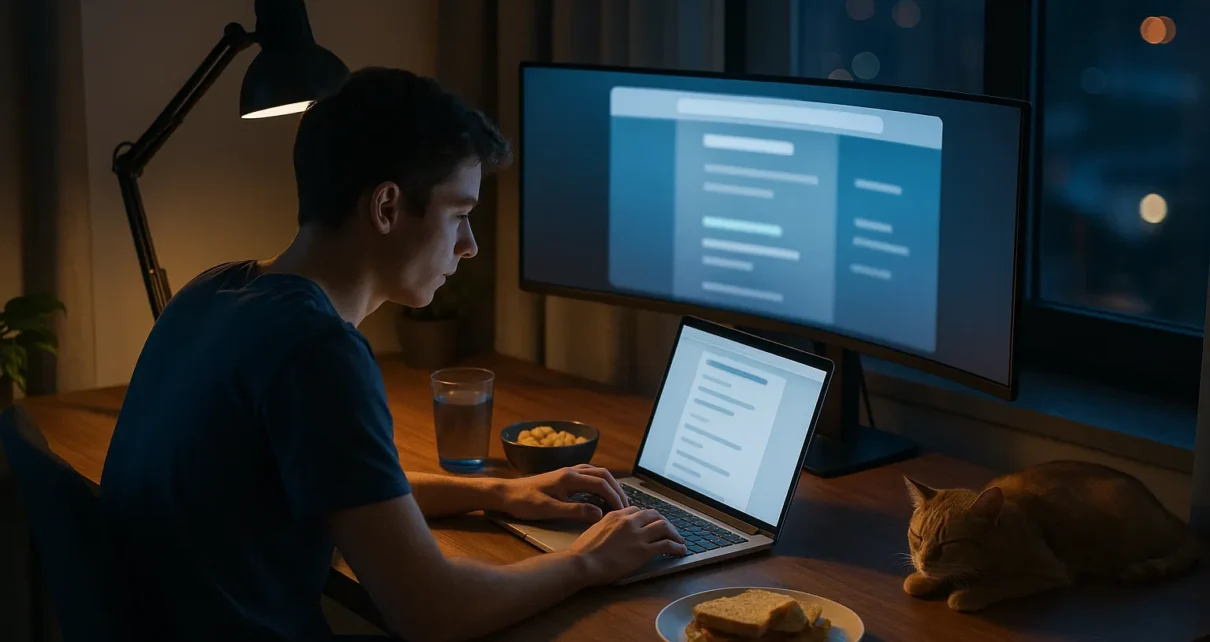Welcome to the complete guide to scrolling behaviour, UX and long-page design.
As Brisbane-based web designers who work on user experiences every day, we know the hard truth: most visitors leave websites after just three seconds. However, we’ve cracked the code to convert those quick scrollers into actual leads.
This guide is meant to teach you how to keep visitors engaged and cut those bounce rates for good. Here’s what we’ll cover:
- Why users abandon pages after just seconds
- What research tells us about scroll patterns
- Simple tricks to keep users scrolling
- Long page design strategies that actually work
- Smart animation guidelines for better UX
Ready to change how people use your site? Wipe off your sweats and fasten your seatbelts, because this ride is about to get serious.
What Research Reveals About How People Scroll
We first started our journey by asking what really happens when someone lands on your page. Guesses got us nowhere. Thus, we started digging into the research and testing on real sites.
What we found was a big shocker. Not only did we find the difference between scrollers, but also how people scroll:

Mobile Scrolling vs Desktop Habits
It’s a fact that mobile users scroll twice as fast as desktop users. They scroll quickly, skimming short paragraphs and moving on in seconds. Desktop users, on the other hand, take their time and engage more deeply (source).
But you might be thinking it’s pretty much the same. Well, you are wrong. We discovered that mobile thumbs move much faster than mouse wheels. As a result, your content needs to work harder to stop them.
The 15-Second Decision Point
We found another mind-blowing factor! Users decide to stay or leave in just 15 seconds. They scan your first screen, then either dive deeper or hit the back button.
Everything hinges on that first impression. Most people spend 10 seconds reading headlines and 5 seconds scanning the first paragraph. If they don’t see value in those moments, they bounce.
Where Eyes Really Go on Long Pages
Lastly, users are like the Mad Hatter, they don’t read in straight lines. They scan in F-patterns on desktop and Z-patterns on mobile. After three scrolls, their attention drops by 60%. Unfortunately, the middle sections of long pages get the least attention compared to the top and bottom areas.
These secrets guide your focus and site plan before you sit down to work on the design elements.
Simple Tips to Keep Visitors Scrolling Down
We now know people’s scrolling patterns. In this section, we are going to cover how these insights help us design pages that work with user behaviour instead of against it. The best part of it all, you don’t need any fancy tools or big budgets to make the fixes.
Through our practical knowledge, we’ve found that small changes make huge differences.

Check out these small design tweaks that could boost your scroll engagement:
- Give your content room to breathe: Have you ever landed on a page where everything feels squished together? It’s overwhelming. Adding generous white space between sections gives the eye a natural pause and makes it easier for people to take in what you’re saying.
- Break it down into snack-sized chunks: We’ve all opened a page, seen a wall of text, and immediately thought, “nope” (I saw one the other day). Keeping paragraphs to two or three sentences makes your content feel lighter, more approachable, and far less intimidating to scroll through.
- Sprinkle in visuals as rest stops. Imagine scrolling down a long page of words and feeling your eyes glaze over. Dropping in an image every few paragraphs gives readers a visual breather and helps reset their focus before they continue.
- Add little touches that feel rewarding. Think of smooth hover effects or a gentle animation when someone interacts with your site. These small moments of feedback make the experience feel polished and enjoyable without being distracting.
Here’s proof it works: We helped a local restaurant redesign its menu page. After adding more white space and breaking up text, visitors stayed on the page much longer and engaged with more sections. Many even called up the owner.
But what if your business has tons of services to share and requires that much content? Hold your horses, we’ve got that covered, too. In such scenarios, you need smart long page strategies.
Long Page Design Tips That Don’t Bore Users
Scroll design basics are done. Now, we will touch down on the bigger fish. Most people think users hate long pages. But that’s not true. People don’t hate long pages. What they really hate are the boring, confusing ones.
There’s a big difference.
Hold on, that went over your head. Let me explain. The length isn’t the problem, it’s the poor structure that kills engagement. Most designers dump everything onto one endless page and hope for the best. That’s a recipe for high bounce rates.
Smart long page design takes the opposite approach. In such a case, the solution is progressive disclosure. This means you reveal information in logical chunks.
I hope you are taking notes.
Excessive information in one place will overwhelm your readers. To tackle that, you should guide them through a story. Think of it like Netflix episodes. Each section should have a clear beginning, valuable content, and a hook that makes users want to continue.
Structuring your pages this way keeps users engaged longer. Basically, you have to use clear section breaks, vary your content types, and always answer “what’s in it for me” in every section. Follow these tips, and your engagement metrics should get a boost right away.
Another way to enhance your users’ experience is by adding animations. But adding it correctly matters too.
Smart Animation Guidelines for Scroll Engagement
Your long page structure is sorted. Now comes the fun part, adding animations that help instead of annoy.
Animations are tricky because if you use them wrong, users get annoyed. But if you use them right, engagement soars. We have tested dozens of animated sites, and maybe this time we’ve got it.
This is how we added scroll animations that boost engagement:

-
- Step 1: Only animate extra content, never the important stuff. Users need to see your contact info and buy buttons right away. Save the fancy effects for images and bonus sections.
- Step 2: Keep your animations between 300-500ms. This timing feels smooth and natural. Go faster and it feels jumpy. Go slower and users think something’s broken.
- Step 3: Test everything on your phone first. Mobile devices handle animations differently than computers do. If it works well on your cell, it will work even better on the desktop.
- Step 4: Add a progress/outline bar for really long pages. When users scroll through tons of content, they want to know how much is left. Think of it like a reading progress meter.
- Step 5: Be careful with parallax backgrounds. They look amazing but can make people feel sick and slow down your site. Use them only on your main hero section.
Remember, animations should enhance the experience, not become the experience. Get these animation principles right, and you’ll notice users staying longer on your pages.
Ready to Transform Your User Experience?
So, the blueprint is in your hands. You can now keep users engaged through smart scrolling design. Though overconfidence can kill, a small celebration doesn’t hurt. The knowledge you have gained from our guide will indeed put you ahead of most websites out there.
People are learning every day. This includes building sites that understand scroll psychology and design for human behaviour. They use research-backed techniques to keep visitors engaged.
For instance, if you were cooking, structuring content the right way is basically following the recipe and adding animations thoughtfully is the salt.
The best part? You are not the only person dealing with this dilemma. Take baby steps. Start by picking your most important page and applying these scroll techniques. Test the changes and see what works. Then expand to other pages based on your results.
We’ve been helping Brisbane businesses create engaging websites for years at GraphEdge. We know these techniques work because we use them every day.
Are you still anxious about the whole process? You can always reach out to an expert at GraphEdge to help put scroll psychology to work on your site.
It’s time to leave your cold feet behind and build something that keeps users scrolling.


